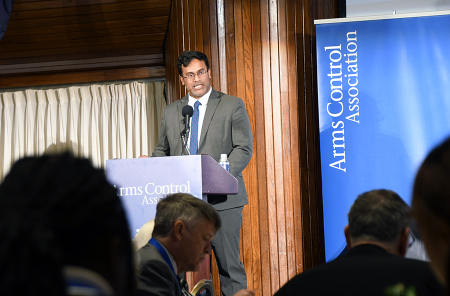Biden Arms Policy Stays Course Despite Buildup
July/August 2024
By Xiaodon Liang
The Biden administration reaffirmed its commitment to arms control negotiations even as major nuclear-armed states expand and modernize their nuclear arsenals.

The United States needs to “persuade our adversaries that managing rivalry through arms control is preferable to unrestrained competition across domains,” a senior U.S. official said in a June 7 restatement of Biden administration nuclear weapons policy.
Speaking to the annual meeting of the Arms Control Association, Pranay Vaddi, the National Security Council’s senior director for arms control, disarmament, and nonproliferation, said that “we have adjusted our strategy to account for a more complex and worsening security environment but we are in no way abandoning our principles.” Those principles, he said, include demonstrating responsible action as a nuclear-weapon power, preventing proliferation, and pursuing arms control arrangements.
According to Vaddi, the administration is “thinking through what a future arms control agreement with Russia…might look like” after the New Strategic Arms Reduction Treaty (New START) expires in February 2026, but it acknowledges that Russia’s rejection of arms control talks “casts a shadow over the likelihood of a New START successor.” The administration believes that Russia “continues to see value in maintaining limits on deployed strategic nuclear weapons” and intends to make public an outline of its ideas for a potential successor treaty, he said.
Vaddi also said that the United States would not “shy away” from discussing China’s proposal for a nuclear no-first-use treaty, affirming comments by Mallory Stewart, assistant secretary of state for arms control, deterrence, and stability, in May. (See ACT, May 2024.) “It would make sense for [China] to try to initiate a more serious discussion in [the P5] format,” he suggested. In August, China will assume the rotating chair of the P5 nuclear process, involving the five states recognized under the nuclear Nonproliferation Treaty as nuclear-weapon states.
In his speech, Vaddi provided some insight into the new nuclear weapons employment guidance that President Joe Biden approved in March. Guidance of this type, which is periodically updated across administrations, typically takes the form of a classified memorandum and may include not only detailed instructions on targets, priorities, and scenarios, but also high-level statements of U.S. policy and assumptions regarding nuclear weapons use that are intended to shape military planning.
The new guidance document, Vaddi said, reaffirms the U.S. intention to abide by the central New START numerical limits until the treaty’s expiration, as long as Russia does the same. He added that unilateral reciprocal statements of continued adherence to the New START limits after February 2026 was a possibility, although the administration does not want to “settle” for this approach.
The guidance also “emphasizes the need to account for the growth and diversity of [China’s] nuclear arsenal,” Vaddi said. The extent of the increase in China’s arsenal will influence the “type of limits we will be able to agree to with Russia,” he said.
The United States is particularly concerned about China’s thinking on the use of lower-yield nuclear weapons in a scenario involving Taiwan, as well as the potential for a future shift of its strategic nuclear posture toward “early-warning counterstrike,” Vaddi said in response to questions following his remarks. He referenced the last iteration of the Defense Department’s annual report on Chinese military forces. (See ACT, November 2023.)
Responding to a reporter’s question about Vaddi’s comments, Chinese Foreign Ministry spokesperson Lin Jian said on June 11 that China “always keeps its nuclear capabilities at the minimum level required by national security.” Speaking at a ministry press conference, Lin said that the United States “has been calling China a ‘nuclear threat’ and using it as a convenient pretext for expanding the U.S.’s own nuclear arsenal aimed at absolute strategic predominance.”
For now, the United States does not intend to “increase our nuclear forces to match or outnumber the combined total of our competitors to successfully deter them,” Vaddi said, reaffirming comments by National Security Advisor Jake Sullivan last year. (See ACT, July/August 2023.)
But “absent a change in the trajectory of adversary arsenals, we may reach a point in the coming years where an increase from current deployed numbers is required, and we need to be fully prepared to execute if the President makes that decision,” Vaddi added.
In response to questions June 8 regarding Vaddi’s speech, Russian foreign ministry spokesperson Maria Zakharova referred journalists to Russia’s existing nuclear doctrine, RIA Novosti reported.
Vaddi also noted recent or ongoing changes to the posture of the deployed U.S. strategic nuclear force below the New START limits.
These include the life extension of certain Ohio-class submarines to provide “additional margin during the transition from legacy to modern capabilities across the triad,” retirement of the B83-1 bomb, and development of the B61-13 bomb variant. (See ACT, December 2023.)
Some members of Congress are pushing forward with additional plans to expand U.S. strategic nuclear forces. The Senate Armed Services Committee, in its version of the fiscal year 2025 defense authorization bill approved June 13, requested that the Defense Department devise a plan to increase the number of deployed intercontinental ballistic missiles (ICBMs) from 400 Minuteman III missiles today to 450 next-generation Sentinel ICBMs.
The bill also directs the Defense Department to recertify all B-52H bombers for nuclear missions and to provide a briefing on returning five to 10 strategic bombers to “alert status.”
The corresponding bill approved by the House Armed Services Committee does not endorse these nuclear force expansions, but it does require the Pentagon to establish plans for a third ground-based missile defense interceptor site, over the Biden administration’s long-standing objections.
The Senate bill also takes the first steps toward shifting the cost of new ICBMs off the Air Force’s budget. In the draft, the committee asks for a briefing on the creation of a National Land-Based Deterrence Fund to pay for the Sentinel program, which has overrun the Defense Department’s September 2020 cost projections by 81 percent. (See ACT, March 2024.)
